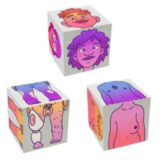Look at the variety of people’s upper bodies in the images – at their breasts, physiques and at the devices they may use. Some people have larger or smaller breasts, some have one breast or two. There are chests with and without hair, with and without scars. As people grow up, some breasts grow more than others. Some people suffer from this, because others may assume them to be more feminine or masculine just by the size of their breasts. But that doesn’t always match their feelings. That’s why some people choose hormones or surgery to change the size of their breasts. Regardless of size, breast cancer can also make it necessary to remove a breast.
Some people are plump and some are thin. People often make guesses about someone’s health or character just by looking at their bodies. For example, a plump person might unfairly be seen as lacking of health, willpower or knowledge. Making such guesses is not a good idea, because plumpness doesn’t tell you how healthy, hard-working or smart someone is.
Some people believe there is a “perfect” body that everyone should look like. But very few people actually do. Ideas about what bodies should look like – plump or thin, small or tall – can hurt the confidence in ourselves and stop us from enjoying all the wonderful things our bodies can do. When people feel like they don’t fit in, they might feel ashamed of their bodies and stay quiet about their feelings. To feel comfortable with out bodies, it helps to connect with them – by moving, breathing deeply and by speaking up when someone makes you feel ashamed of your amazing body.
One person in the picture is wearing a patch on their arm. This is an insulin pump, a special patch that helps people with diabetes. Diabetes means that a person has too much sugar in their blood because their body doesn’t produce enough insulin, the hormone that reduces blood sugar, or because it cannot use insulin well. An insulin pump controls the blood sugar level. Once people get used to it, it can make life safer and more flexible. Still, it’s always better to ask someone how they feel about wearing it rather than making assumptions.
One of the pictures shows a person with a bag attached to their belly. This person had an operation, in which the bowel is connected to a small opening in the belly (colostomy). This allows the digested food to leave the body through the bag instead of through the anus. Such belly openings (stomas) can help to treat various diseases. They can be temporary or permanent. Wearing a colostomy bag can cause anger, sadness or fears of how other people might react. That’s why being kind to people living with those bags is so important. The more everyone understands these bags, the easier it is to support those who have them.
